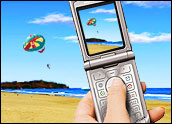
New research indicates that the number of mobile phone subscribers will increase by upwards of 50 percent in the next four years.
According to the latest research from the wireless network strategies service of Boston-based Strategy Analytics, the mobile industry is on course for 2.5 billion subscribers by the end of 2006, and 3.5 billion by the end of 2010. In this report, called, “Worldwide Cellular User Forecasts, 2005-2010,” the firm also predicts the industry will generate US$800 billion in service revenues by the end of the decade.
Two Key Trends
“There were two key trends in the global wireless market in 2005,” said Phil Kendall, director of the global wireless practice at Strategy Analytics. “First, emerging markets contributed phenomenal levels of subscriber growth. In particular, Russia, India and Indonesia saw major growth in new users in 2005, up 40-50 percent over 2004 levels.”
What’s more, the study said, African nations, including Nigeria and Algeria, are “waiting in the wings” to become leading growth markets in 2006, and will propel the worldwide cellular subscriber count to 2.5 billion before the end of the year.
“The second key trend was the coming of age of the high-speed 3G market,” said Kendall.
W-CDMA user numbers also jumped last year, from 16 million to 49 million during 2005, with CDMA2000 1x EV-DO users up from 12 million to 26 million. “Europe finally joined Japan in delivering meaningful W-CDMA numbers, while the USA also made leaps in EV-DO. We expect both of these technologies will double their subscriber counts in 2005,” said David Kerr, vice president of Strategy Analytics.
Reasons for Usage Growth
Another survey released this month, the Sprint U.S. Consumer Wireless Usage Study, by Sprint, shows a number of reasons why mobile phone usage is exploding. The study said that more than half of wireless phone subscribers — 56 percent — rely on their mobile phones for features such as cameras, clocks, calendars, messaging, music and as a substitute flashlight for seeing in dark places.
“Whether it’s using location-based services to get driving directions, listening to streaming music or watching live TV, consumers are finding that the mobile phone is the one item they depend on most to stay connected and entertained,” said Jeff Hallock, vice president of product marketing and strategy for Sprint, based in Overland Park, Kan.
One-third of respondents — 33 percent — said they want to play games on their phones. Those who currently do play games on their phones shared some interesting insight into their gaming habits. Fifty-seven percent claim to have played games in the doctor’s office, 52 percent while commuting on the bus, train or subway, 37 percent while at the airport and nearly one-third of gamers — 32 percent — sheepishly admit to using the bathroom as a game room.
“Sprint continues to see a strong interest in mobile games from both casual gamers and active gamers – and some are complete fanatics about it,” said Hallock. “For example, one customer has played Bejeweled Multiplayer by Jamdat more than 40,000 times – that’s almost 2,000 hours of game play!”
Multiple Uses
Another popular feature might even put an end to the age-old in-car argument over the need to stop and ask for directions. Nearly two-thirds of respondents — 63 percent — said they would use their wireless phone to retrieve maps or directions.
The study said cameras remain popular with wireless users, with 55 percent expressing interest in the product.
Showing further evidence of the interest in camera phones, 53 percent of camera phone owners take photos with their phone. The overwhelming majority of these “phone-tographers” use their camera phones for spontaneous pictures; nearly one-third take pictures at family gatherings or of their pets, while more than one-quarter snap pictures at celebrations or on vacation.
“Images captured on camera phones are not simply stored on the phone,” Hallock said. “[Consumers] enjoy the ease and convenience of instantly taking, sharing, preserving, managing, editing, and printing digital images that are accessible from their phone and personal computer.”



















































